Coins First National Coinage Of Barbados 1973


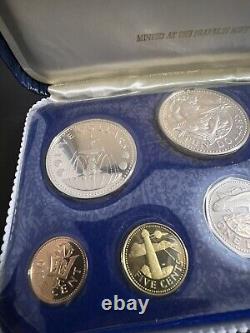
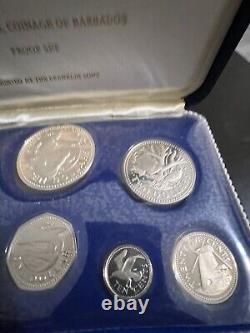
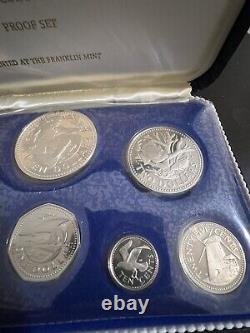
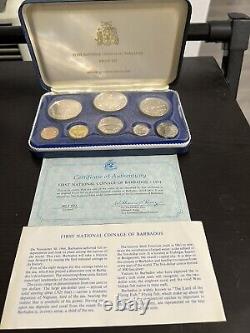
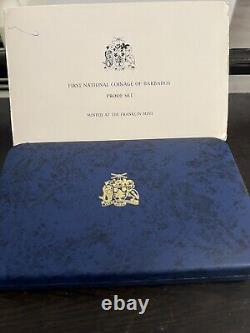

COINS FIRST NATIONAL COINAGE OF BARBADOS 1973. Complete set in the box with the Certificate of Authenticity signed and For the Franklin Mint. 1973 Proof Set You get a Silver 10 Dollar, Silver 5 Dollar, Copper-Nickel 2 Dollar, Copper-Nickel 1 Dollar, Copper-Nickel 25 Cent, Copper-Nickel 10 Cent, Copper-Nickel 5 Cent and a Copper 1 Cent.
Experience the history of Barbados in this proof set from 1973. Minted at the Franklin Mint. THE 10 DOLLAR COIN IS: 1973. FM Proof Silver 10 Dollars 42mm (37.90 grams) 0.925 Silver 1.1271 oz. ASW Reference: KM# 17a (1973-81) TEN DOLLARS, Neptune, the god of the sea, seated right, holding trident placing a hand on a fish.
PRIDE AND INDUSTRY 1973 BARBADOS, National coat-of-arms of Barbados with motto inscribed below; year across central fields. THE 5 DOLLAR COIN IS: 1973. Proof Silver 5 Dollars 40mm (32.03 grams) 0.800 Silver 0.7999 oz.
ASW Reference: KM# 16 PRIDE AND INDUSTRY 1974 BARBADOS, National Arms. FIVE DOLLARS PN, Shell Fountain in Bridgetown's Trafalgar Square. THE 2 DOLLAR COIN IS: 1973. Proof Copper-Nickel 2 Dollars 37mm 20.00. Grams Reference: KM# 14.1 PRIDE AND INDUSTRY 1973 BARBADOS, National Arms. TWO DOLLARS, Staghorn coral (Acropora cervicornis) and two fish swimming around coral. THE 1 DOLLAR COIN IS: 10th Anniversary of Independence 1973.Proof Copper-Nickel 1 Dollar 28mm 6.32. Grams Reference: KM# 23 1973 PRIDE AND INDUSTRY BARBADOS, Coat of arms of Barbados divides date. ONE DOLLAR PN, Flying fish left, value below.
THE 25 CENT COIN IS. Proof Copper-Nickel 25 Cent 23.66mm (37.90 grams) Reference: KM# 13 19 75 PRIDE AND INDUSTRY BARBADOS, National Arms. TWENTY FIVE CENTS PN, Windmill below value. THE 10 CENT COIN IS. Proof Copper-Nickel 10 Cent 17.77mm (2.29 grams) Reference: KM# 12 19 75 PRIDE AND INDUSTRY BARBADOS, National Arms. PN Ten cents, Tern flying left, value below. THE 5 CENT COIN IS. Proof Copper-Nickel 5 Cent 23.65mm (5.65 grams) Reference: KM# 13 19 75 PRIDE AND INDUSTRY BARBADOS, National Arms. Notes: The Morgan Lewis Windmill is one of only two functional windmills in the Caribbean.Built in 1727 and in operation until 1945, the mill was used to grind sugar cane and could deliver up to 1,500 gallons of cane juice to the boiling house daily. After 1945, when the mill stopped operating, it fell into disrepair and was at one time listed among the world's most endangered heritage sites. Grinding is done at Morgan Lewis every second Sunday between the months of January and April, and the mill and its grounds are open for tours.
THE 1 CENT COIN IS. Proof Bronze 1 Cent 19mm (3.11 grams) Reference: KM# 10 19 75 PRIDE AND INDUSTRY BARBADOS, National Arms. PN ONE CENT, Trident above value. Barbados is an island country in the Lesser Antilles of the West Indies, in the Caribbean region of North America.
It is 34 kilometres (21 miles) in length and up to 23 km (14 mi) in width, covering an area of 432 km. It is situated in the western area of the North Atlantic and 100 km (62 mi) east of the Windward Islands and the Caribbean Sea.
Therein, Barbados is east of the Windwards, part of the Lesser Antilles, roughly at 13°N of the equator. It is about 168 km (104 mi) east of both the countries of Saint Lucia and Saint Vincent and the Grenadines and 400 km (250 mi) north-east of Trinidad and Tobago. Barbados is outside the principal Atlantic hurricane belt. Its capital and largest city is Bridgetown.
Inhabited by Kalinago people since the 13th century, and prior to that by other Amerindians, Barbados was visited by Spanish navigators in the late 15th century and claimed for the Spanish Crown. It first appeared in a Spanish map in 1511.
The Portuguese visited the island in 1536, but they left it unclaimed, with their only remnants being an introduction of wild hogs for a good supply of meat whenever the island was visited. Olive Blossom, arrived in Barbados in 1625; its men took possession of it in the name of King James I. In 1627, the first permanent settlers arrived from England, and it became an English and later British colony. As a wealthy sugar colony, it became an English centre of the African slave trade until that trade was outlawed in 1807, with final emancipation of slaves in Barbados occurring over a period of years from 1833. On 30 November 1966, Barbados became an independent state and Commonwealth realm with the British monarch (currently Queen Elizabeth II) as hereditary head of state. It has a population of 284,996 people, predominantly of African descent. Despite being classified as an Atlantic island, Barbados is considered to be a part of the Caribbean, where it is ranked as a leading tourist destination. Forty percent of the tourists come from the UK, with the US and Canada making up the next large groups of visitors to the island.
